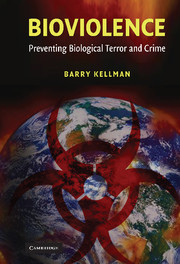Book contents
- Frontmatter
- Contents
- Prologue
- Foreword, by Ronald K. Noble, Interpol Secretary General
- Acknowledgments
- Introduction
- PART I THE BIOVIOLENCE CONDITION AND HOW IT CAME TO BE
- PART II THE GLOBAL STRATEGY FOR PREVENTING BIOVIOLENCE
- 4 Strategic Foundations
- 5 Complication: What Law Enforcers Should Stop
- 6 Improving Resistance through Science
- 7 Public Health Preparedness
- 8 International Nonproliferation
- 9 The Challenge of Global Governance
- Conclusion
- Notes
- Bibliography
- Index
6 - Improving Resistance through Science
Published online by Cambridge University Press: 27 July 2009
- Frontmatter
- Contents
- Prologue
- Foreword, by Ronald K. Noble, Interpol Secretary General
- Acknowledgments
- Introduction
- PART I THE BIOVIOLENCE CONDITION AND HOW IT CAME TO BE
- PART II THE GLOBAL STRATEGY FOR PREVENTING BIOVIOLENCE
- 4 Strategic Foundations
- 5 Complication: What Law Enforcers Should Stop
- 6 Improving Resistance through Science
- 7 Public Health Preparedness
- 8 International Nonproliferation
- 9 The Challenge of Global Governance
- Conclusion
- Notes
- Bibliography
- Index
Summary
Bioscience is not just an activity or set of knowledge. It is a uniquely accelerating phenomenon that evokes inquiries about humanity's most existential search – what is the architecture of life? Our era is witnessing an unprecedented revolution in human comprehension of the physics of life. Yesterday's flights of imagination are today's reality. Only the best scientific minds can predict where the rush of scientific advance will take us tomorrow, and even they can only guess at what might be conventional wisdom in a few brief decades.
Knowledge of fundamental life processes has progressed to the point that extensive human intervention in the course of natural evolution has apparently become feasible, not only to determine particular outcomes but to redirect the process itself. … As a result, the human species is relentlessly acquiring power far in excess of its vision and this is thereby posing monumental problems of prudential judgment – problems that society is not yet conceptually or institutionally equipped to handle.
This bioscience revolution offers enormously beneficial prospects for curing disease that necessarily expose how pathogens exploit human vulnerabilities. Unfortunately, these scientific advances could supply knowledge for the commission of heinous violence. Thus, at the core of research to protect against bioviolence is a paradox: To learn how to defeat disease is to learn how it works. As the 21st Century opens, bioscience's precious potential is intertwined with cascades of new threats. Techniques that generate life-saving progress are the same techniques that could generate catastrophic bioviolence.
- Type
- Chapter
- Information
- BioviolencePreventing Biological Terror and Crime, pp. 132 - 159Publisher: Cambridge University PressPrint publication year: 2007



